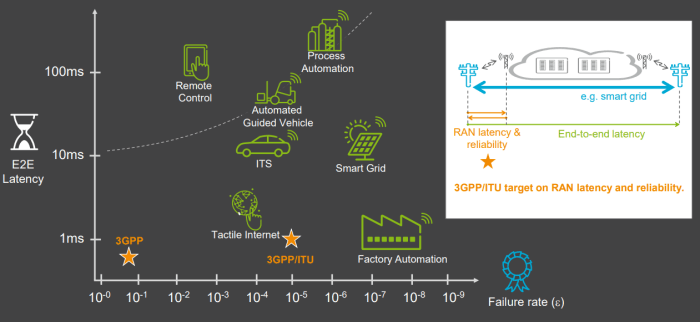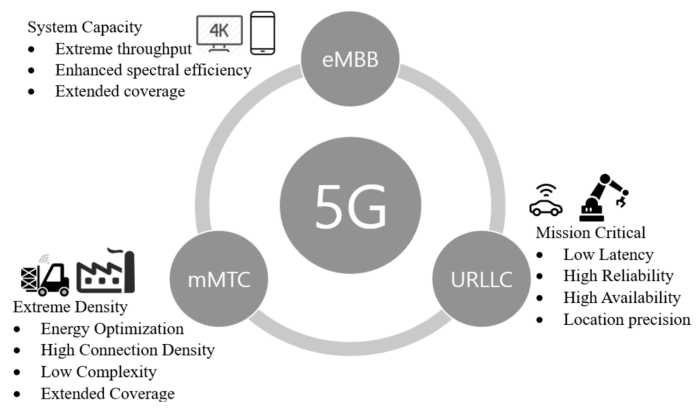The urllc 5g category focuses on communications in smart cities – The 5G URLLC category focuses on communications in smart cities, addressing critical challenges and enabling a wide range of applications that enhance urban living. This technology empowers smart cities with seamless and reliable communication, paving the way for improved efficiency, sustainability, and citizen engagement.
5G’s ultra-reliable low-latency communication (URLLC) capabilities are tailored to meet the demanding requirements of smart city applications, ensuring uninterrupted data transmission and real-time responsiveness.
Smart City Communication

Effective communication is the backbone of smart cities, enabling the seamless flow of information between various stakeholders, including citizens, government agencies, businesses, and infrastructure. The advent of 5G technology has revolutionized smart city communications, addressing the challenges of data-intensive applications and real-time decision-making.
5G networks offer significantly improved bandwidth, latency, and reliability, enabling the development and deployment of innovative applications that leverage real-time data analysis, artificial intelligence (AI), and the Internet of Things (IoT). These applications can optimize city operations, enhance citizen services, and foster economic growth.
Applications and Use Cases
Smart city communications using 5G technology have numerous applications and use cases, including:
- Traffic Management:Real-time traffic monitoring and optimization, reducing congestion and improving commute times.
- Public Safety:Enhanced emergency response systems, providing faster and more efficient coordination.
- Smart Grids:Optimized energy distribution and consumption, reducing energy waste and improving grid resilience.
- Environmental Monitoring:Real-time monitoring of air quality, noise levels, and other environmental factors, enabling proactive measures.
- Citizen Engagement:Interactive platforms for citizens to provide feedback, access information, and participate in decision-making.
Technical Aspects
5G technology incorporates several technical advancements that make it ideal for smart city communications:
- High Bandwidth:Enables the transmission of large amounts of data, supporting real-time applications and IoT devices.
- Low Latency:Reduces the delay in data transmission, allowing for near-instantaneous response times and real-time decision-making.
- Massive Connectivity:Supports a vast number of connected devices, facilitating the deployment of IoT sensors and smart infrastructure.
- Network Slicing:Enables the creation of virtual networks with tailored performance characteristics, optimizing communication for specific applications.
- Edge Computing:Brings computation and data processing closer to the edge of the network, reducing latency and improving application performance.
Benefits and Impacts, The urllc 5g category focuses on communications in smart cities
The use of 5G for smart city communications brings numerous benefits and positive impacts:
- Improved Efficiency:Real-time data and automation enable more efficient operations, reducing costs and improving resource utilization.
- Enhanced Sustainability:Optimized energy consumption, reduced traffic congestion, and improved environmental monitoring contribute to a more sustainable city.
- Increased Citizen Engagement:Interactive platforms and real-time information empower citizens and foster community involvement.
- Economic Growth:Smart city applications and infrastructure create new business opportunities and attract investment.
- Improved Quality of Life:Enhanced services, reduced congestion, and a cleaner environment improve the overall quality of life for citizens.
Challenges and Considerations
While 5G offers significant potential, it also presents challenges and considerations:
- Infrastructure Deployment:Building and maintaining 5G networks requires significant investment and coordination.
- Security and Privacy:The vast amount of data collected and transmitted raises concerns about security and data privacy.
- Device Compatibility:Ensuring compatibility between different devices and applications can be a challenge.
- Cost and Affordability:The cost of deploying and maintaining 5G networks and devices may be a barrier to adoption.
- Skills and Expertise:Implementing and managing 5G networks requires specialized skills and expertise.
Future Trends and Outlook
The future of 5G in smart city communications holds exciting possibilities:
- 6G and Beyond:The next generation of wireless technology, 6G, promises even higher speeds and lower latency.
- Edge AI:Increased adoption of AI at the edge of the network will further enhance real-time decision-making and improve application performance.
- Integrated Platforms:Smart city platforms will become more integrated, connecting various applications and services.
- Virtual and Augmented Reality:5G will enable immersive experiences and applications using virtual and augmented reality.
- Smart City as a Service (SCaaS):Cloud-based services will make it easier to deploy and manage smart city applications.
FAQ Section: The Urllc 5g Category Focuses On Communications In Smart Cities
What are the key benefits of 5G URLLC for smart cities?
5G URLLC offers ultra-reliable and low-latency communication, enabling real-time data transmission and seamless connectivity for smart city applications.
How does 5G URLLC support IoT devices in smart cities?
5G URLLC provides the necessary bandwidth and reliability for a massive number of IoT devices to communicate and exchange data efficiently.
What are some examples of 5G URLLC applications in smart cities?
5G URLLC enables applications such as autonomous vehicles, remote healthcare, smart grids, and real-time traffic management.

